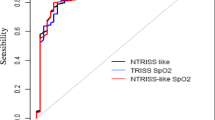Summary
The association between the increasing severity of systemic inflammatory response syndrome (SIRS) and the incidence of posttraumatic complications and mortality was retrospectively investigated in 1278 injured patients. Patients were divided into three groups according to their Injury Severity Score (ISS) (group A: ISS L 9 K16 points (n = 626); group B: ISS > 16 < 40 points (n = 589); group C: ISS L 40 points (n = 63)). SIRS was defined according to the criteria of the American Consensus Conference. The number of fulfilled criteria determined its severity: moderate SIRS: 2 criteria fulfilled, intermediate SIRS: 3 criteria fulfilled, severe SIRS: 4 criteria fulfilled. Additionally, acute respiratory distress syndrome (ARDS) was defined according to the Murray-Score and the multiple organ dysfunction syndrome (MODS) according to the Goris-Score. The incidence of SIRS was 42 % in group A, 70 % in group B and 100 % in group C (p < 0.05). The severity of SIRS increased with severity of trauma. Moreover, 178 of all injured patients (14 %) developed septic complications. In parallel to SIRS, the incidence of these septic complications correlated with the severity of trauma. The occurrence and severity of ARDS and MODS correlated with increased severity of SIRS and septic complications. Among patients without SIRS 15 % developed ARDS and 21 % MODS. In contrast, patients with severe SIRS and septic complications demonstrated ARDS in 99 % and MODS in 97 %. In these patients, no correlation was found between the ISS and the incidence of ARDS or MODS. There were also stepwise increases in mortality rates in the hierarchy from SIRS to septic shock. While 13 of patients with modest SIRS (5 %) and 32 of patients with intermediate SIRS (13 %) died, the mortality rate of patients with severe SIRS was 19 % (p < 0.05). In addition, a significant correlation between the incidence of septic complications and mortality was found. Injured patients with sepsis died in 13 %, those with severe sepsis in 23 %, and patients with septic shock in 33 % (p < 0.05). Thus, the increasing severity of SIRS was associated with the occurrence of posttraumatic ARDS, MODS, and mortality. Using the number of fulfilled SIRS criteria for classifying systemic inflammation, its severity may be predictive for posttraumatic complications and outcome of injured patients.
Zusammenfassung
In einer retrospektiven Analyse wurde bei 1278 verletzten Patienten der Schweregrad der Ganzkörperinflammation [systemic inflammatory response syndrome (SIRS)] mit der Häufigkeit von posttraumatischen Komplikationen und der Letalität korreliert. Die Patienten wurden in Abhängigkeit vom Verletzungsschweregrad in drei Gruppen unterteilt: Injury Severity Score (ISS) L 9 K16 Punkte (n = 626), ISS > 16 < 40 Punkte (n = 589), ISS L 40 Punkte (n = 63). Für die Diagnose SIRS wurde die Definition der Amerikanischen Konsensuskonferenz verwendet und der SIRS-Schweregrad entsprechend der Anzahl erfüllter Kriterien ermittelt: leichtes SIRS: 2 erfüllte Kriterien, mittelschweres SIRS: 3 erfüllte Kriterien, schweres SIRS: 4 erfüllte Kriterien. Das akute Lungenversagen (ARDS) wurde nach dem Murray-Score und das Multiorgandysfunktionssyndrom (MODS) nach dem Goris-Score definiert. Die Inzidenz der Ganzkörperinflammation betrug für das gesamte Patientenkollektiv 57,6 %. Mit steigendem ISS zeigte sich eine erhöhte Inzidenz und ein erhöhter SIRS-Schweregrad (p < 0,05); 42 % der Patienten mit leichter Verletzung, 70 % der Patienten mit schwerer Verletzung und alle Patienten mit einem ISS > 40 Punkten entwickelten ein SIRS. Septische Kompliationen fanden sich bei 178 aller Patienten (14 %). Die Inzidenz septischer Komplikationen korrelierte wie das SIRS mit dem ISS (p < 0,05). Die Häufigkeit und der Schweregrad von ARDS und MODS korrelierten mit der Schwere von Ganzkörperinflammation und septischen Komplikationen. Patienten ohne SIRS entwickelten nur in 15 % ein Lungenversagen und in 21 % ein MODS. Hingegen wiesen Patienten mit septischen Komplikationen in 99 % ein ARDS und in 97 % ein MODS auf. Bei septischen Patienten war die Häufigkeit von ARDS oder MODS vom ISS unabhängig. Die Letalität verletzter Patienten korrelierte mit dem Schweregrad der Ganzkörperinflammation. Während 13 Patienten mit leichtem SIRS (5 %) und 32 Patienten mit mittelschwerem SIRS (13 %) starben, lag die Letalität von Patienten mit schwerem SIRS bei 19 % (p < 0,05). Zusätzlich zeigte sich eine signifikante Korrelation zwischen der Inzidenz septischer Komplikationen und der Letalität. Verletzte Patienten mit einer Sepsis starben in 13 %, solche mit schwerer Sepsis in 23 % und Patienten im septischen Schock in 33 % (p < 0,05). Die Einteilung des SIRS und der Sepsis in unterschiedliche Schweregrade könnte für die Früherkennung des Organ- und Multiorganversagens und für die Prognose verletzter Patienten von Bedeutung sein.
Similar content being viewed by others
Author information
Authors and Affiliations
Rights and permissions
About this article
Cite this article
Ertel, W., Keel, M., Marty, D. et al. The significance of the systemic inflammatory response syndrome (SIRS) in 1278 trauma patients. Unfallchirurg 101, 520–526 (1998). https://doi.org/10.1007/s001130050304
Published:
Issue Date:
DOI: https://doi.org/10.1007/s001130050304




